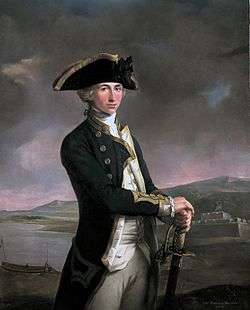San Juan Expedition (1780)
| ||||||||||||||||||||||||||||||
The San Juan Expedition took place between March and November 1780 during the American War of Independence when a British force under the command of John Polson and Captain Horatio Nelson landed on the coast of the present-day Nicaragua, with the aim of sailing up the San Juan River to capture the strategically crucial towns of Granada and León, located on the northwestern shore of Lake Nicaragua.
Despite an initial success in the capture of the Fortress of the Immaculate Conception, Polson's force never reached Lake Nicaragua and, decimated by yellow fever, was forced to return to Jamaica. The campaign ended in total failure and cost the lives of more than 2,500 men, making it the costliest British disaster of the entire war.[6]
Background
After Spain entered the American Revolutionary War in 1779, Major-General John Dalling, the governor of Jamaica, proposed a military expedition against the Spanish province of Nicaragua, belonging then to the Captaincy General of Guatemala, a dependency of the Viceroyalty of New Spain. The main objective of the expedition was to capture the town of Granada, effectively cutting Spanish America in half and giving Great Britain access to the Pacific Ocean.[7] "The colours of England, were, in their imagination, already in the walls of Lima."[8]
Expedition
The expedition, consisting of the transport Penelope, two brigs, three sloops, and a tender, the Royal George, sailed from Jamaica on 3 February 1780, escorted by the 21-year-old Captain Horatio Nelson in the 28-gun HMS Hinchinbrook. Nelson was the highest-ranking officer present, but his authority was limited to naval operations.[9] The overall commander was Captain (local rank of major) John Polson, who had at his disposal about 3,000 men, including 100 regulars of the 60th Royal American Regiment under himself, 140 of the 79th Liverpool Blues under Captain Richard Bulkeley, 240 Royal Jamaica Volunteers under Major James Macdonald, 250 members of the Jamaica Legion, and 125 of the Royal Batteaux Corps, plus an unspecified number of black volunteers.[2]

On 24 March, after many delays awaiting the arrival of several Miskito Indian bowmen under Major James Lawrie, which failed to appear,[10] the expedition anchored off San Juan del Norte. Three days later all Polson's troops were assembled aboard boats and advanced upriver divided in two contingents.[10] On 9 April, Nelson, in the first hand-to-hand combat of his career, led an assault which captured a small Spanish battery on Bartola Island.[9]
Five miles (8 km) upstream was Fort San Juan, with about 160 armed defenders of whom only 60 were soldiers,[10] which was besieged beginning on 13 April. Because of poor planning and lost supplies, the British soon began to run low on ammunition for the cannons as well as rations for the men.[9] After the tropical rains started on 20 April, men began to sicken and die, probably of malaria and dysentery, and maybe of typhoid fever,[11] Nelson was one of the first to become ill, and he was shipped downriver on 28 April,[12] the day before the Spanish under Juan de Ayssa, devoid of ammunition, food and water, surrendered the fort.[5]
The British troops, unable to advance despite the arrival of 450 British reinforcements on 15 May, remained in occupation of the fort for six months, during which time they perished by the hundreds,[10] while Viceroy Matías de Gálvez was able to fortify the mouth of Lake Nicaragua.[5] The Spanish gained in strength, thanks to assistance from San Miguel, Choluteca and other adjoining provinces, while sickness continued to take a heavy toll among the British troops, forcing the order for withdrawal to be given on 30 November.
Aftermath
The Spanish reoccupied the remains of the fort, which the British had blown up on departure. Despite having surrendered it, Don Juan de Ayssa was promoted to lieutenant colonel, as was recorded in the Royal Order of 12 June 1781: he had alerted the other garrisons in the area, bravely defended the fort, suffered hardships as a prisoner of war, and contributed greatly to creating difficulties for the British operations. Taken prisoner to Jamaica, he was freed at the end of the war and rose to become governor of Nicaragua in 1783.[13]
Notes
References
- Chávez, Thomas E (2004). Spain and the Independence of the United States: An Intrinsic Gift. UNM Press. ISBN 978-0-8263-2794-9. OCLC 149117944.
- Coleman, Terry (2004). The Nelson Touch: The Life and Legend of Horatio Nelson. London, UK: Oxford University Press. ISBN 978-0-19-517322-2.
- Dolores Gómez, José (1975). Historia de Nicaragua desde los tiempos prehistóricos hasta 1860: en sus relaciones con España, Mexico y Centro-America. Banco de America.
- Knight, Roger (2007). The Pursuit of Victory: The Life and Achievement of Horatio Nelson. UK: Westview Press. ISBN 978-0-465-03765-0.
- Linebaugh, Peter; Rediker, Marcus (2005). La hidra de la revolución: marineros, esclavos y campesinos en la historia oculta del Atlántico. Editorial Critica. ISBN 978-84-8432-601-4.
- Marley, David (1998). Wars of the Americas: a chronology of armed conflict in the New World, 1492 to the present. Santa Barbara, USA: ABC-CLIO. ISBN 978-0-87436-837-6.
- de Saavedra de Sangronis, Francisco; Francisco Morales Padrón (2004). Diario de don Francisco de Saavedra. Madrid, Spain: Universidad de Sevilla. ISBN 978-84-472-0782-4.
- Southey, Robert (2007). The Life of Horatio Lord Nelson. Teddington, UK: Echo Library. ISBN 978-1-4068-3003-3.
- Sudgen, John (2004). Nelson: A Dream of Glory, 1758–1797. New York, USA: Holt. ISBN 0-224-06097-X.
Coordinates: 11°01′09″N 84°23′47″W / 11.01917°N 84.39639°W
